Business Law Assignment: Partnership and Joint Venture Comparison
VerifiedAdded on 2020/04/21
|7
|1219
|176
Report
AI Summary
This report provides a comparative analysis of partnerships and joint ventures, two common forms of unincorporated business structures. It outlines the key features of partnerships, including shared risks and rewards, profit sharing, unlimited liability, decision-making rights, ownership sharing, flexibility, privacy, taxation, and tenure. The report contrasts these features with those of joint ventures, which are typically formed for specific projects and lack the long-term nature of partnerships. It also examines relevant legislation in Australia governing both structures. The report concludes by advising on the most suitable business structure for Xiaojing, Lance, and Nick's herbal product business, recommending a partnership due to its suitability for long-term operations and greater commitment from partners, supported by references to legal and business resources.

Running head: BUSINESS LAW
Business law
Name of the Student
Name of the University
Author Note
Business law
Name of the Student
Name of the University
Author Note
Paraphrase This Document
Need a fresh take? Get an instant paraphrase of this document with our AI Paraphraser
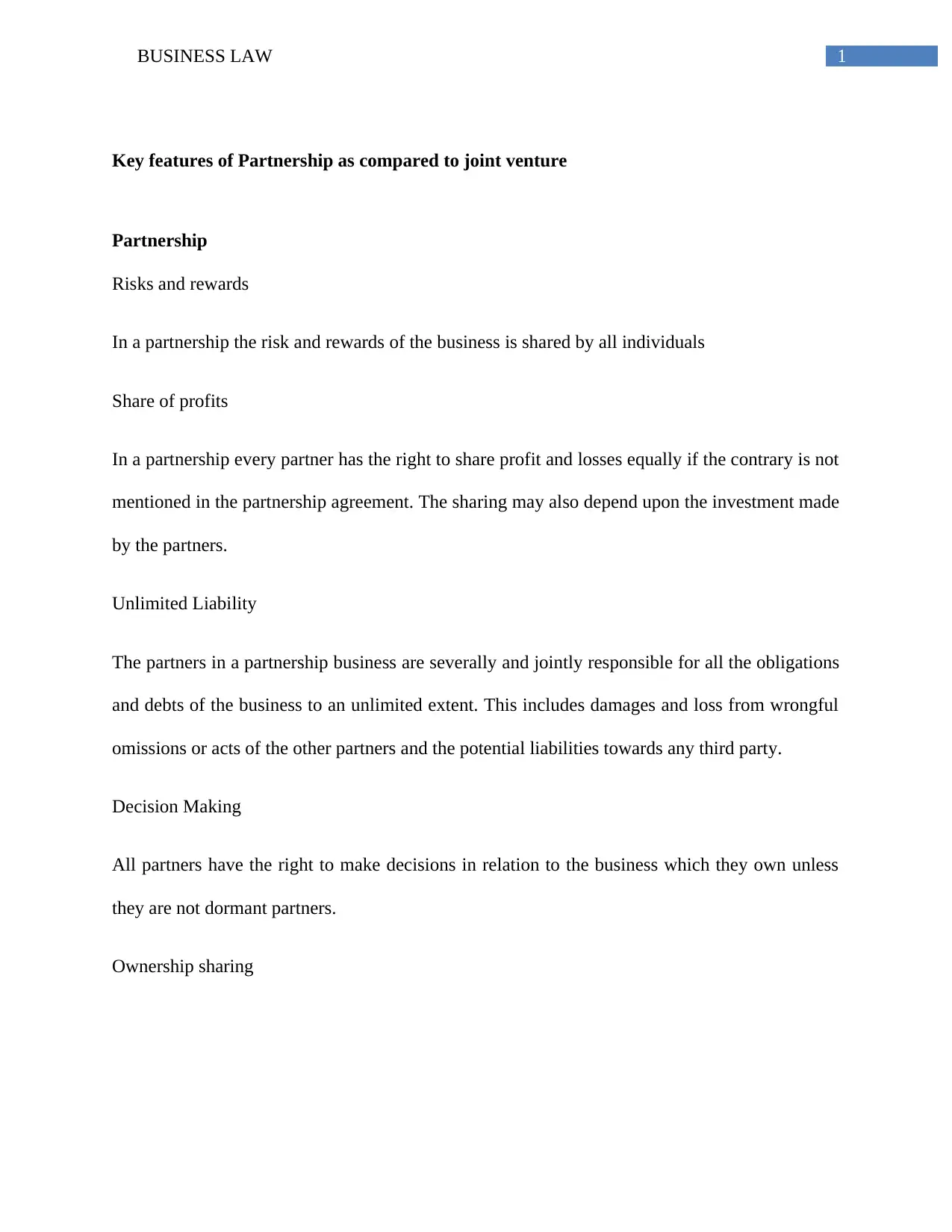
1BUSINESS LAW
Key features of Partnership as compared to joint venture
Partnership
Risks and rewards
In a partnership the risk and rewards of the business is shared by all individuals
Share of profits
In a partnership every partner has the right to share profit and losses equally if the contrary is not
mentioned in the partnership agreement. The sharing may also depend upon the investment made
by the partners.
Unlimited Liability
The partners in a partnership business are severally and jointly responsible for all the obligations
and debts of the business to an unlimited extent. This includes damages and loss from wrongful
omissions or acts of the other partners and the potential liabilities towards any third party.
Decision Making
All partners have the right to make decisions in relation to the business which they own unless
they are not dormant partners.
Ownership sharing
Key features of Partnership as compared to joint venture
Partnership
Risks and rewards
In a partnership the risk and rewards of the business is shared by all individuals
Share of profits
In a partnership every partner has the right to share profit and losses equally if the contrary is not
mentioned in the partnership agreement. The sharing may also depend upon the investment made
by the partners.
Unlimited Liability
The partners in a partnership business are severally and jointly responsible for all the obligations
and debts of the business to an unlimited extent. This includes damages and loss from wrongful
omissions or acts of the other partners and the potential liabilities towards any third party.
Decision Making
All partners have the right to make decisions in relation to the business which they own unless
they are not dormant partners.
Ownership sharing
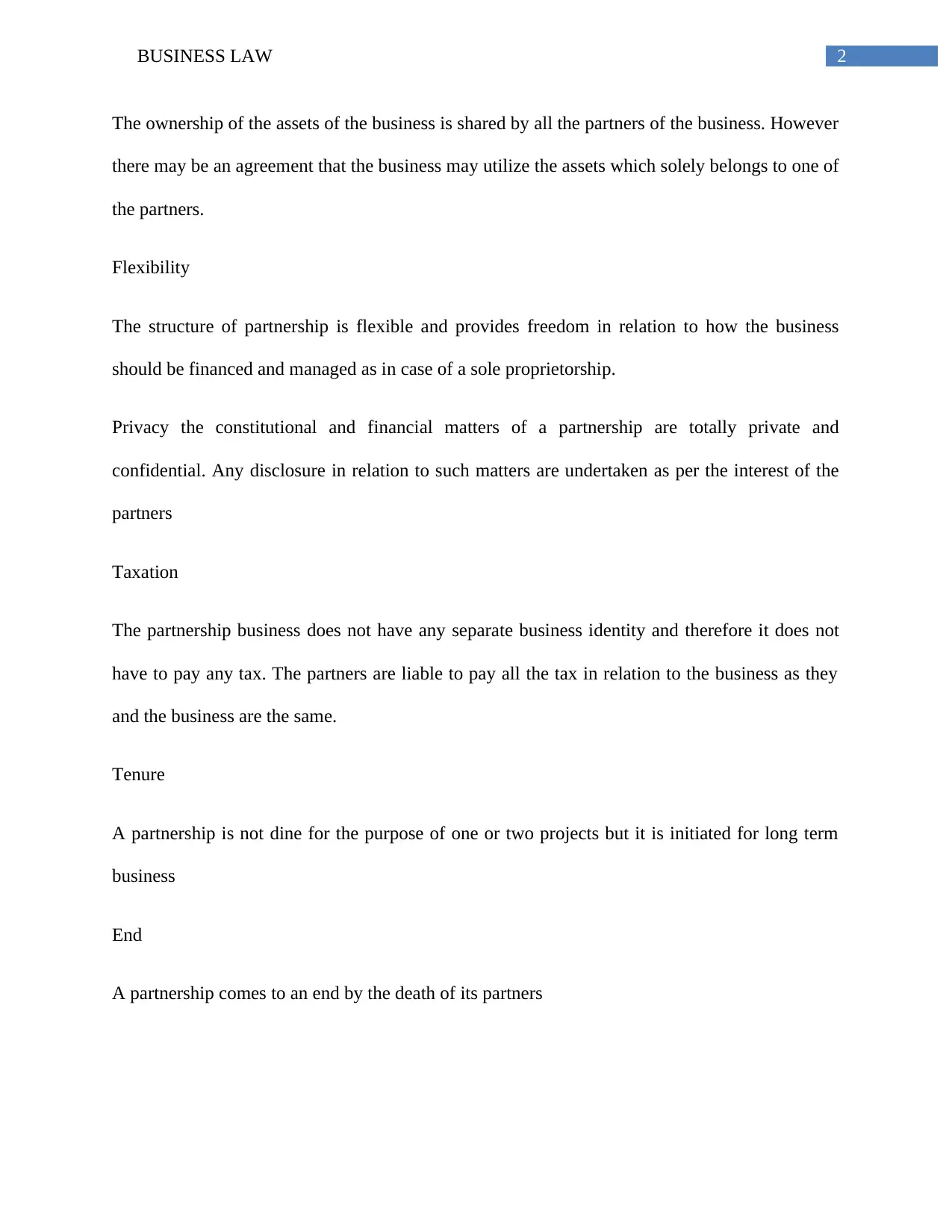
2BUSINESS LAW
The ownership of the assets of the business is shared by all the partners of the business. However
there may be an agreement that the business may utilize the assets which solely belongs to one of
the partners.
Flexibility
The structure of partnership is flexible and provides freedom in relation to how the business
should be financed and managed as in case of a sole proprietorship.
Privacy the constitutional and financial matters of a partnership are totally private and
confidential. Any disclosure in relation to such matters are undertaken as per the interest of the
partners
Taxation
The partnership business does not have any separate business identity and therefore it does not
have to pay any tax. The partners are liable to pay all the tax in relation to the business as they
and the business are the same.
Tenure
A partnership is not dine for the purpose of one or two projects but it is initiated for long term
business
End
A partnership comes to an end by the death of its partners
The ownership of the assets of the business is shared by all the partners of the business. However
there may be an agreement that the business may utilize the assets which solely belongs to one of
the partners.
Flexibility
The structure of partnership is flexible and provides freedom in relation to how the business
should be financed and managed as in case of a sole proprietorship.
Privacy the constitutional and financial matters of a partnership are totally private and
confidential. Any disclosure in relation to such matters are undertaken as per the interest of the
partners
Taxation
The partnership business does not have any separate business identity and therefore it does not
have to pay any tax. The partners are liable to pay all the tax in relation to the business as they
and the business are the same.
Tenure
A partnership is not dine for the purpose of one or two projects but it is initiated for long term
business
End
A partnership comes to an end by the death of its partners
⊘ This is a preview!⊘
Do you want full access?
Subscribe today to unlock all pages.

Trusted by 1+ million students worldwide
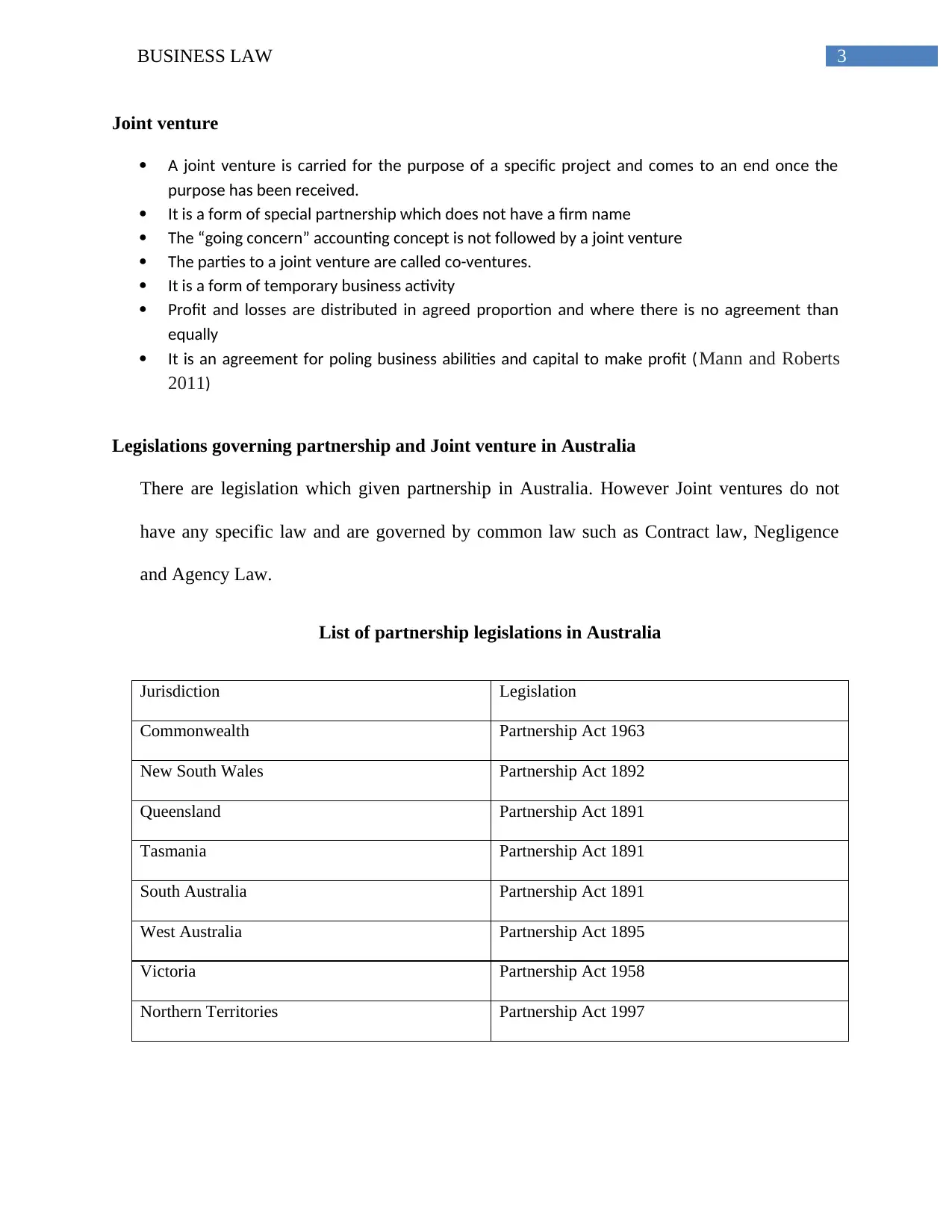
3BUSINESS LAW
Joint venture
A joint venture is carried for the purpose of a specific project and comes to an end once the
purpose has been received.
It is a form of special partnership which does not have a firm name
The “going concern” accounting concept is not followed by a joint venture
The parties to a joint venture are called co-ventures.
It is a form of temporary business activity
Profit and losses are distributed in agreed proportion and where there is no agreement than
equally
It is an agreement for poling business abilities and capital to make profit ( Mann and Roberts
2011)
Legislations governing partnership and Joint venture in Australia
There are legislation which given partnership in Australia. However Joint ventures do not
have any specific law and are governed by common law such as Contract law, Negligence
and Agency Law.
List of partnership legislations in Australia
Jurisdiction Legislation
Commonwealth Partnership Act 1963
New South Wales Partnership Act 1892
Queensland Partnership Act 1891
Tasmania Partnership Act 1891
South Australia Partnership Act 1891
West Australia Partnership Act 1895
Victoria Partnership Act 1958
Northern Territories Partnership Act 1997
Joint venture
A joint venture is carried for the purpose of a specific project and comes to an end once the
purpose has been received.
It is a form of special partnership which does not have a firm name
The “going concern” accounting concept is not followed by a joint venture
The parties to a joint venture are called co-ventures.
It is a form of temporary business activity
Profit and losses are distributed in agreed proportion and where there is no agreement than
equally
It is an agreement for poling business abilities and capital to make profit ( Mann and Roberts
2011)
Legislations governing partnership and Joint venture in Australia
There are legislation which given partnership in Australia. However Joint ventures do not
have any specific law and are governed by common law such as Contract law, Negligence
and Agency Law.
List of partnership legislations in Australia
Jurisdiction Legislation
Commonwealth Partnership Act 1963
New South Wales Partnership Act 1892
Queensland Partnership Act 1891
Tasmania Partnership Act 1891
South Australia Partnership Act 1891
West Australia Partnership Act 1895
Victoria Partnership Act 1958
Northern Territories Partnership Act 1997
Paraphrase This Document
Need a fresh take? Get an instant paraphrase of this document with our AI Paraphraser
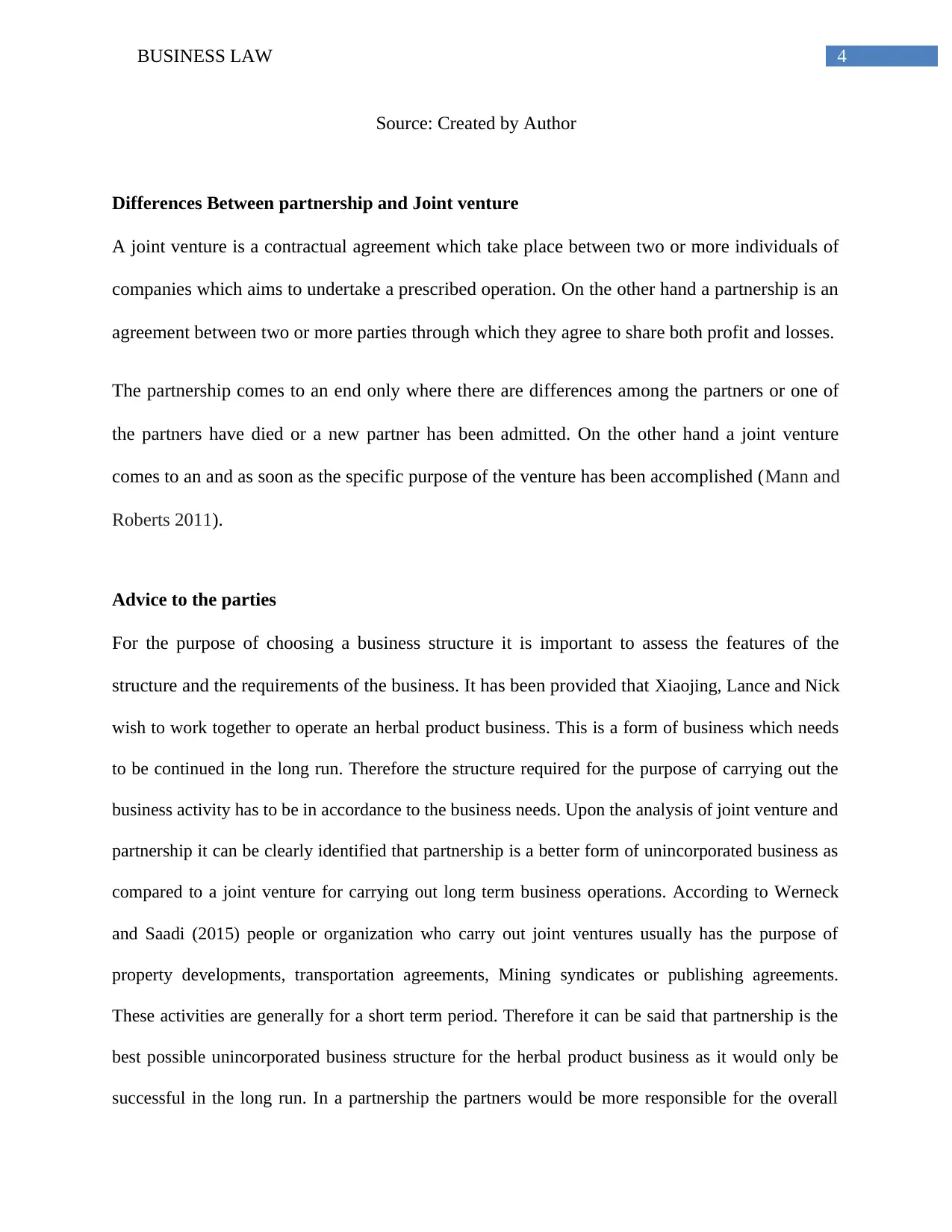
4BUSINESS LAW
Source: Created by Author
Differences Between partnership and Joint venture
A joint venture is a contractual agreement which take place between two or more individuals of
companies which aims to undertake a prescribed operation. On the other hand a partnership is an
agreement between two or more parties through which they agree to share both profit and losses.
The partnership comes to an end only where there are differences among the partners or one of
the partners have died or a new partner has been admitted. On the other hand a joint venture
comes to an and as soon as the specific purpose of the venture has been accomplished (Mann and
Roberts 2011).
Advice to the parties
For the purpose of choosing a business structure it is important to assess the features of the
structure and the requirements of the business. It has been provided that Xiaojing, Lance and Nick
wish to work together to operate an herbal product business. This is a form of business which needs
to be continued in the long run. Therefore the structure required for the purpose of carrying out the
business activity has to be in accordance to the business needs. Upon the analysis of joint venture and
partnership it can be clearly identified that partnership is a better form of unincorporated business as
compared to a joint venture for carrying out long term business operations. According to Werneck
and Saadi (2015) people or organization who carry out joint ventures usually has the purpose of
property developments, transportation agreements, Mining syndicates or publishing agreements.
These activities are generally for a short term period. Therefore it can be said that partnership is the
best possible unincorporated business structure for the herbal product business as it would only be
successful in the long run. In a partnership the partners would be more responsible for the overall
Source: Created by Author
Differences Between partnership and Joint venture
A joint venture is a contractual agreement which take place between two or more individuals of
companies which aims to undertake a prescribed operation. On the other hand a partnership is an
agreement between two or more parties through which they agree to share both profit and losses.
The partnership comes to an end only where there are differences among the partners or one of
the partners have died or a new partner has been admitted. On the other hand a joint venture
comes to an and as soon as the specific purpose of the venture has been accomplished (Mann and
Roberts 2011).
Advice to the parties
For the purpose of choosing a business structure it is important to assess the features of the
structure and the requirements of the business. It has been provided that Xiaojing, Lance and Nick
wish to work together to operate an herbal product business. This is a form of business which needs
to be continued in the long run. Therefore the structure required for the purpose of carrying out the
business activity has to be in accordance to the business needs. Upon the analysis of joint venture and
partnership it can be clearly identified that partnership is a better form of unincorporated business as
compared to a joint venture for carrying out long term business operations. According to Werneck
and Saadi (2015) people or organization who carry out joint ventures usually has the purpose of
property developments, transportation agreements, Mining syndicates or publishing agreements.
These activities are generally for a short term period. Therefore it can be said that partnership is the
best possible unincorporated business structure for the herbal product business as it would only be
successful in the long run. In a partnership the partners would be more responsible for the overall
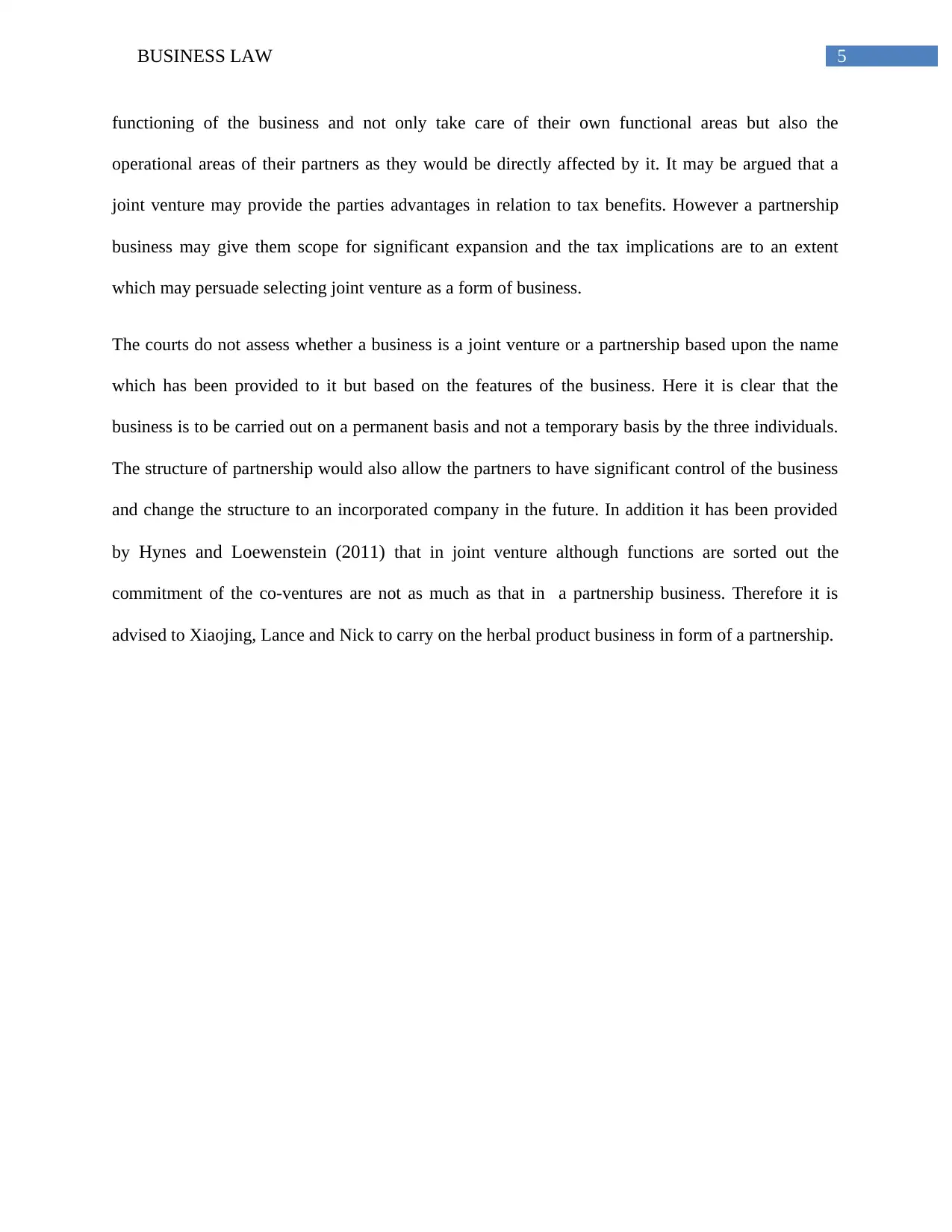
5BUSINESS LAW
functioning of the business and not only take care of their own functional areas but also the
operational areas of their partners as they would be directly affected by it. It may be argued that a
joint venture may provide the parties advantages in relation to tax benefits. However a partnership
business may give them scope for significant expansion and the tax implications are to an extent
which may persuade selecting joint venture as a form of business.
The courts do not assess whether a business is a joint venture or a partnership based upon the name
which has been provided to it but based on the features of the business. Here it is clear that the
business is to be carried out on a permanent basis and not a temporary basis by the three individuals.
The structure of partnership would also allow the partners to have significant control of the business
and change the structure to an incorporated company in the future. In addition it has been provided
by Hynes and Loewenstein (2011) that in joint venture although functions are sorted out the
commitment of the co-ventures are not as much as that in a partnership business. Therefore it is
advised to Xiaojing, Lance and Nick to carry on the herbal product business in form of a partnership.
functioning of the business and not only take care of their own functional areas but also the
operational areas of their partners as they would be directly affected by it. It may be argued that a
joint venture may provide the parties advantages in relation to tax benefits. However a partnership
business may give them scope for significant expansion and the tax implications are to an extent
which may persuade selecting joint venture as a form of business.
The courts do not assess whether a business is a joint venture or a partnership based upon the name
which has been provided to it but based on the features of the business. Here it is clear that the
business is to be carried out on a permanent basis and not a temporary basis by the three individuals.
The structure of partnership would also allow the partners to have significant control of the business
and change the structure to an incorporated company in the future. In addition it has been provided
by Hynes and Loewenstein (2011) that in joint venture although functions are sorted out the
commitment of the co-ventures are not as much as that in a partnership business. Therefore it is
advised to Xiaojing, Lance and Nick to carry on the herbal product business in form of a partnership.
⊘ This is a preview!⊘
Do you want full access?
Subscribe today to unlock all pages.

Trusted by 1+ million students worldwide
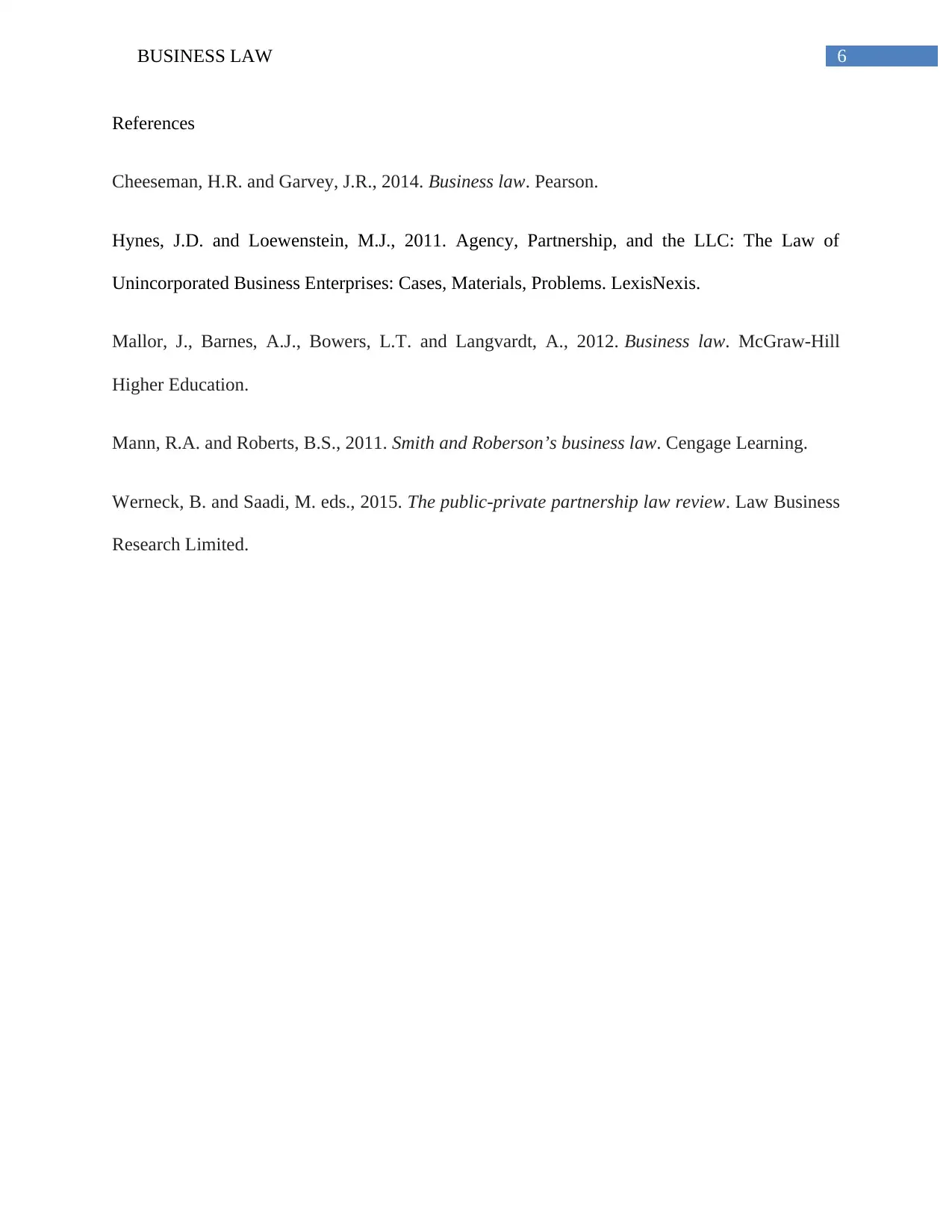
6BUSINESS LAW
References
Cheeseman, H.R. and Garvey, J.R., 2014. Business law. Pearson.
Hynes, J.D. and Loewenstein, M.J., 2011. Agency, Partnership, and the LLC: The Law of
Unincorporated Business Enterprises: Cases, Materials, Problems. LexisNexis.
Mallor, J., Barnes, A.J., Bowers, L.T. and Langvardt, A., 2012. Business law. McGraw-Hill
Higher Education.
Mann, R.A. and Roberts, B.S., 2011. Smith and Roberson’s business law. Cengage Learning.
Werneck, B. and Saadi, M. eds., 2015. The public-private partnership law review. Law Business
Research Limited.
References
Cheeseman, H.R. and Garvey, J.R., 2014. Business law. Pearson.
Hynes, J.D. and Loewenstein, M.J., 2011. Agency, Partnership, and the LLC: The Law of
Unincorporated Business Enterprises: Cases, Materials, Problems. LexisNexis.
Mallor, J., Barnes, A.J., Bowers, L.T. and Langvardt, A., 2012. Business law. McGraw-Hill
Higher Education.
Mann, R.A. and Roberts, B.S., 2011. Smith and Roberson’s business law. Cengage Learning.
Werneck, B. and Saadi, M. eds., 2015. The public-private partnership law review. Law Business
Research Limited.
1 out of 7
Related Documents
Your All-in-One AI-Powered Toolkit for Academic Success.
+13062052269
info@desklib.com
Available 24*7 on WhatsApp / Email
![[object Object]](/_next/static/media/star-bottom.7253800d.svg)
Unlock your academic potential
Copyright © 2020–2025 A2Z Services. All Rights Reserved. Developed and managed by ZUCOL.




